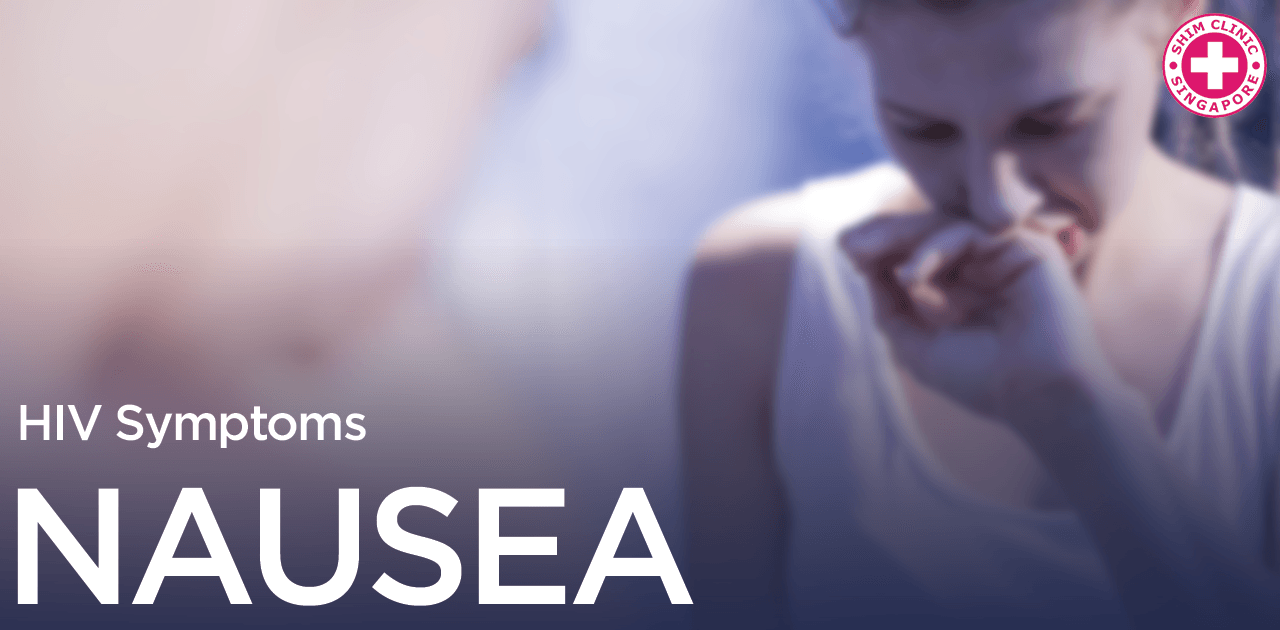HIV Nausea Singapore | Shim Clinic
| Help me about HIV Nausea ! |

| Permalink: https://shimclinic.sg/hiv-nausea |
Nausea can have many different causes. In some cases, it’s a symptom of acute HIV infection. It can also be a side effect of HIV medication, or can have many other causes unrelated to HIV. If you develop unexplained nausea and may have been exposed to HIV, you need an HIV test.
Nausea is a common symptom and can have many different causes. Nausea is sometimes accompanied by other symptoms, like vomiting and loss of appetite, but not always. People with HIV may experience nausea for several reasons.
During the early phase of the infection (called acute HIV infection), HIV can cause a variety of general symptoms of infection. Nausea is one of these symptoms, along with fever, rash, and fatigue. People who have an acute HIV infection may experience nausea throughout the day, or it may come and go. It will tend to linger for weeks, which is a clue that it’s not due to a regular viral illness, from which most people recover much faster.
People who are on HIV medication sometimes experience nausea as a side effect of their medications. Although it can be unpleasant, this is not a reason to stop taking the medications, because the effects of untreated HIV are far worse. Your doctor can prescribe an anti-nausea medication that can help you to feel better while still taking your lifesaving HIV medication.
- Nausea is a very common symptom with many potential causes.
- People with HIV may experience nausea early in the course of the infection (during the acute phase of the infection), along with other symptoms like fever, rash, and fatigue.
- HIV medications themselves can also cause nausea. This side effect can be treated with anti-nausea medication. Do not stop your HIV medication because of nausea.
- If you develop nausea and have had any possible HIV exposures, you need to let your doctor know about the exposures so that you can get an HIV test.
- Diagnosing HIV early in the course of the infection gives the best chance for keeping the virus under control with medications and living a relatively normal life.
If you develop nausea, and you have had any possible exposures to HIV (for instance, if you were having sex and your condom broke), then you might have an acute HIV infection. However, there are also many other very common infections that can cause nausea, including viruses and bacteria that can be transmitted through food or on surfaces (like doorknobs and sink handles). If you have other possible HIV symptoms, like a rash, then it may be more likely that you have HIV, but it’s still not possible to diagnose HIV without an HIV test. Other infections that cause nausea are also more common in people with more advanced HIV infection, because their immune systems aren’t working properly.
Because there are so many common causes of nausea, your doctor may not do an HIV test unless you reveal that you’ve had one or more possible exposures. Make sure you tell your doctor if you’ve had unprotected sex with new partners, if you had a condom break while having sex with an HIV-positive partner or one of unknown status, or if you have shared any equipment while injecting drugs. This will let your doctor know that your symptoms may be HIV symptoms and you need an HIV test. If you hide your exposures out of embarrassment, you might not find out that you have HIV until you have severe symptoms later in the course of the infection, and it will be much harder to get the virus under control at that point.
Sources:
Mayo Clinic. “STD symptoms: Common STDs and their symptoms.” Mayo Clinic. Published 18 Mar 2015. Accessed 20 Jul 2016. http://www.mayoclinic.org/std-symptoms/art-20047081
Centers for Disease Control and Prevention. “Screening Recommendations Referenced in Treatment Guidelines and Original Recommendation Sources.” Centers for Disease Control and Prevention. Published 04 Jun 2015. Accessed 20 Jul 2016. http://www.cdc.gov/std/tg2015/screening-recommendations.htm
Centers for Disease Control and Prevention. “HIV/AIDS.” Centers for Disease Control and Prevention. Published 05 Jul 2016. Accessed 27 Jul 2016. http://www.cdc.gov/hiv/
Centers for Disease Control and Prevention. “HIV Basics – Testing.” Centers for Disease Control and Prevention. Published 12 Jul 2016. Accessed 20 Jul 2016. http://www.cdc.gov/hiv/basics/testing.html
U.S. Department of Health & Human Services. “Post-Exposure Prophylaxis (PEP).” AIDS.gov. Published 21 Sep 2015. Accessed 20 Jul 2016. https://www.aids.gov/hiv-aids-basics/prevention/reduce-your-risk/post-exposure-prophylaxis/
| Timeline | HIV | STD | Pregnancy |
|---|---|---|---|
| Before exposure | |||
| Contraception (females only) | |||
| HIV PrEP (pre-exposure prophylaxis) - Stop HIV infection before exposure | STD vaccine: - Hepatitis vaccine - HPV vaccine | ||
| STD / HIV exposure | |||
| 0-72 hours | HIV PEP (post-exposure prophylaxis) - Stop HIV infection after exposure | STD testing * - Screening test - to look for asymptomatic infections - from previous exposures | Emergency contraception with the morning-after pill (females only) |
| 2 weeks | HIV DNA Test | ||
| 1 month | HIV 4th Generation Test - SD Bioline HIV Ag/Ab Combo - Fingerprick blood sampling. - 20 minutes to results | ||
| 3 months | HIV 3rd Generation Test - OraQuick® HIV-1/2 Antibody - Oral fluid or - Fingerprick blood sampling. - 20 minutes to results | STD testing * - Full & comprehensive - diagnostic test - to look for current infections | |
| Watch for | HIV Symptoms | STD Symptoms | |
| If infected | HIV Treatment | STD Treatment | Abortion |
References